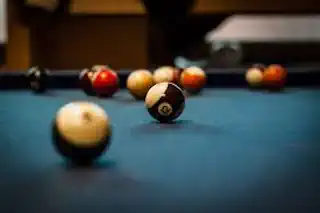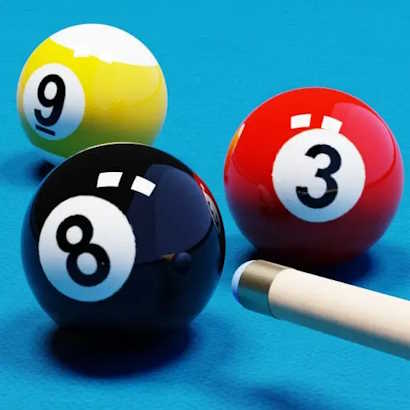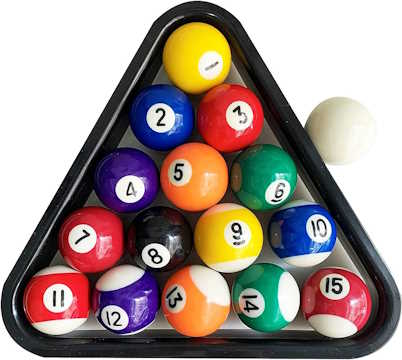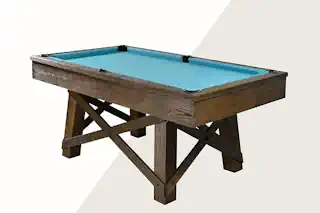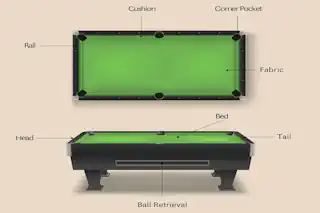A Beginners Guide to Bumper Pool: Everything You Need to Know
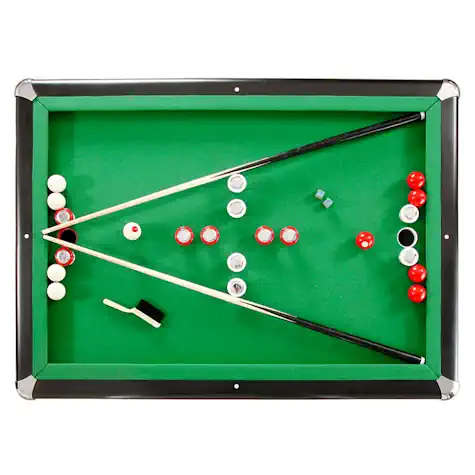
Hey there! Are you looking for a fun and engaging game that the whole family can enjoy? Or perhaps you’re a recreational player keen on adding a new game to your repertoire. Well, you’ve come to the right place! Today, we’re exploring the wonderful world of bumper pool, a game that promises endless fun and a bit of friendly competition.
Introduction to Bumper Pool
Bumper pool is a unique billiards game that has captured the hearts of many. Its roots trace back to the early 20th century, gaining popularity for its compact size and engaging gameplay. Unlike a standard pool table, bumper pool tables are smaller and filled with obstacles, making strategic play a key element of the game. If you have never had a chance to play bumper pool then it is time to find a table and give it a try. It’s the perfect addition to family game nights, offering a blend of challenge and excitement for players of all ages.
Setting Up Your Bumper Pool Table
Got your new table? Fantastic! Setting it up is straightforward but requires a bit of attention to detail. Follow the assembly instructions closely—each piece is crucial for the perfect game setup. When choosing a spot in your home, look for a well-lit area with enough space for players to move around comfortably. The right environment will make your bumper pool experience even more enjoyable.
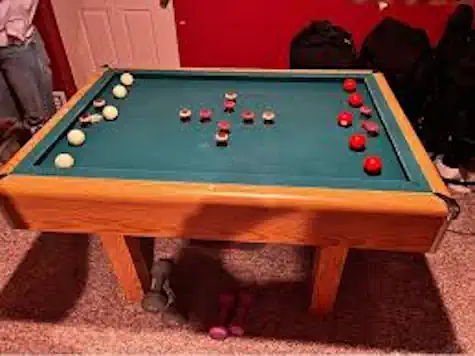
Typical Space and Environment Requirements for a Bumper Pool Table
To ensure you have the best bumper pool experience, it’s essential to set up your table in the right environment. Here are some key considerations:
Adequate Space: You’ll need about 10 feet by 10 feet of space to accommodate the table and allow players to move freely.
Good Lighting: Ensure the area is well-lit, either through natural light or strategically placed lighting fixtures.
Stable Flooring: Place the table on a level, stable surface to prevent any wobbling during play.
Comfortable Temperature: Aim for a room with a comfortable temperature, avoiding areas with extreme humidity or temperature fluctuations.
Low Traffic Area: Choose a spot with minimal foot traffic to avoid interruptions during the game.
Accessibility: Ensure easy access to all sides of the table for hassle-free gameplay.
Setting up your bumper pool table in an optimal space will enhance the playing experience and ensure everyone has a great time!
Bumper Pool Table Size
When it comes to bumper pool tables, size truly matters. The standard dimensions for a bumper pool table are typically around 4 feet by 5 feet, although you may find some variations. This compact size makes it ideal for homes with limited space, unlike larger billiard tables. The smaller dimensions also mean that the game is more approachable for younger players, making it a fantastic choice for family fun.
Keep in mind that the table’s playing surface is surrounded by bumpers, which are essential obstacles that add to the game’s unique charm. So, whether you’re placing the table in a basement, game room, or even a living room, its manageable size ensures that you can find the perfect spot to fit it easily.
Bumper Pool 101: Rules and Gameplay
The essence of bumper pool lies in its simplicity and the strategic depth it offers. The game is played with two players (or teams) aiming to sink all their balls into the pocket on the opposite end of the table before their opponent does. But, here’s the catch—the middle of the table is dotted with bumpers, making direct shots tricky. Developing a strategy and mastering bank shots are key to becoming a bumper pool pro.
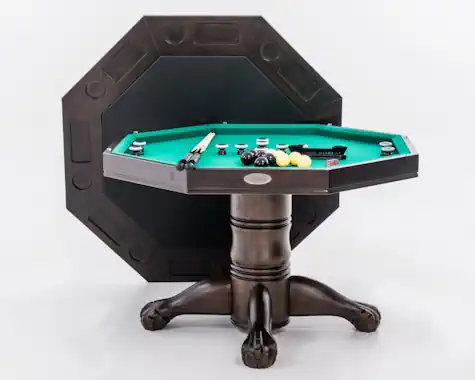
To help you get started, here’s a list of the essential bumper pool rules:
Number of Players: Bumper pool is typically played with two players or two teams.
Starting Position: Each player begins with five balls, one white or yellow (depending on the table’s markings) and four red. Position the balls on the designated spots on your side of the table.
Opening Shot: Players take turns shooting their colored balls towards the opposite pocket. Typically, the player with the marked white ball starts.
Objective: The goal is to sink all of your balls into the opponent’s scoring hole before your opponent sinks their balls in your scoring hole.
Bumpers: The bumpers act as obstacles, making direct shots challenging. Utilize bank shots to navigate around them.
Fouls: If a player pockets an opponent’s ball, it is considered a foul. The misplaced ball is returned to its original spot, and the player’s turn ends. A ball off the table is also a foul.
Turns: Players alternate turns, as players sink their balls in the opponent’s pocket they continue shooting. Otherwise, each player gets one shot per turn.
Scoring: No formal scoring system is typically used beyond tracking who sinks their balls first.
As you can see, the rules of bumper pool are simple. By following these rules, you’ll ensure that the game remains fair and fun for everyone involved!
Bumper Pool Strategies
Now that you’re familiar with the basic rules and setup of bumper pool, it’s time to dive into some strategies that can give you an edge over your opponents. While bumper pool is relatively easy to learn, mastering it requires a fair amount of skill and tactical thinking. Here are a few tips to help elevate your game:
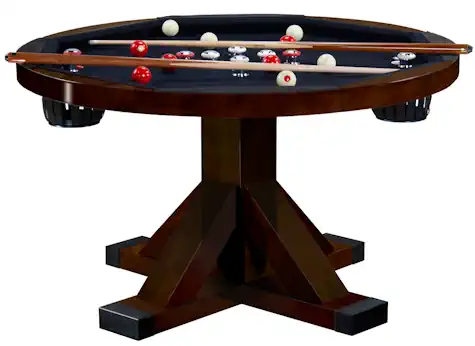
Master the Bank Shots
Bank shots are a fundamental skill in bumper pool. Unlike pool, where you might have clear paths to the pockets, bumper pool requires you to navigate around obstacles. Practice using the bumpers to redirect your shots into the pocket. The more comfortable you get with bank shots, the more you’ll be able to control the game’s flow.
Control the Center Bumpers
The bumpers at the center of the table can either be your best friend or your worst enemy. Develop a strategy to control the space around these bumpers. Blocking your opponent’s path while maintaining clear lines for your own shots can make a significant difference. Consider defensive plays that force your opponent into more difficult shots.
Focus on Precision, Not Power
Powerful shots may seem tempting, but they often lead to unpredictable outcomes. Precision is much more valuable in bumper pool. Take your time to line up each shot carefully, focusing on accuracy rather than force. This approach reduces the risk of inadvertently pocketing one of your balls, opponent’s balls or missing your own. Even hitting the center of the bumpers can still push your balls anywhere on the table.
Plan Your Moves Ahead
Much like chess, bumper pool rewards players who think several moves ahead. Try to anticipate your opponent’s shots and plan your moves accordingly. Setting up future shots can provide you with better opportunities and limit your opponent’s options.
Practice Defensive Shots
Sometimes the best offense is a good defense. If you find yourself in a tough spot, a defensive shot can reposition your balls or block your opponent’s shots on your side of the table. Practice placing your balls in locations that make it difficult for your opponent to score, while setting yourself up for easier future shots.
Adapt to Your Opponent
Every player has a unique playing style. Pay attention to your opponent’s strategies and adapt your game accordingly. Are they aggressive, aiming for quick wins? Or do they play defensively, waiting for you to make a mistake? Understanding their approach will help you tailor your own strategy to counteract their moves.
By integrating these strategies into your bumper pool gameplay, you’ll not only improve your chances of winning but also find greater enjoyment in the game. Remember, practice makes perfect, so keep honing your skills and enjoy the challenges that each next game of bumper pool brings!
Bumper Pool Maintenance
To ensure your bumper pool table stands the test of time, regular maintenance is essential. Keep the ball off the table, surface clean and dust-free, and inspect the bumpers and pockets for wear and tear. Encountering issues like a stuck ball or loose bumper? Don’t worry, most problems have simple fixes, such as adjusting the table legs for balance or tightening screws.
To keep your bumper pool table in top condition, regular care and maintenance are key. Here are some basic tips to ensure your table remains in excellent shape:
Regular Cleaning: Dust the table surface at least once a week with a soft, dry cloth. For deeper cleaning, use a damp cloth and mild detergent, then wipe it dry.
Inspect the Bumpers: Check that all bumpers are securely fastened and undamaged. Tighten any loose screws and replace bumpers that show signs of significant wear.
Balancing the Table: Ensure the table legs are even and the surface is level. Unevenness can affect gameplay, so adjust the legs as needed for optimal balance.
Checking Pockets: Periodically inspect the pockets for any damage or wear. Repair or replace them if necessary to maintain smooth play.
Maintaining Balls: Clean the balls regularly with a damp cloth to remove dirt and debris. This helps in maintaining the smooth roll during the game.
Avoiding Extreme Conditions: Keep the table in a room with a stable temperature and humidity level. Extreme conditions can cause the wood to warp and affect the table’s integrity.
Routine Inspections: Perform a thorough check-up of the table every few months, tightening screws, inspecting for damage, and ensuring all components are in good condition.
Prompt Repairs: Address any issues immediately, whether it’s a loose bumper or a slight tilt in the table. Quick fixes prevent minor problems from becoming major ones.
By following these simple maintenance tips, you’ll ensure your bumper pool table provides endless hours of fun and remains a staple of your game nights for years to come!
Choosing the Right Bumper Pool Table
If you’re in the market for a bumper pool table, consider size, quality, and budget. Think about the space you have available and your commitment level. There are many reputable brands and models, each with its pros and cons. Reading reviews and comparing features will help you find the perfect match for your home and family.
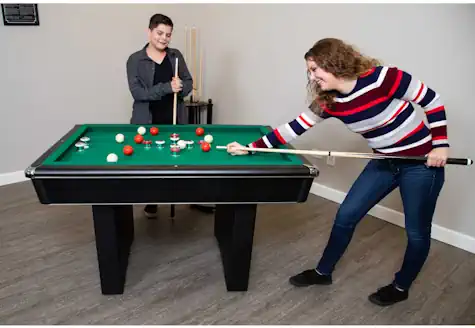
Typical Cost and Models of Bumper Pool Tables
Choosing the right bumper pool table involves not just understanding your space and needs but also knowing what’s available on the market and how much it might cost. Here is a list of typical costs and popular models to help guide your decision:
Fairview Game Rooms Bumper Pool Table
Cost: $1,100 – $1,500
Features: High-quality wood construction, professional-grade felt, in-built ball and cue holders.
Hathaway Renegade Slate Bumper Pool Table
Cost: $900 – $1,200
Features: Modern design, durable slate surface, comes with all accessories needed for play.
Berner Billiards The Norwich Bumper Pool Table
Cost: $1,200 – $1,600
Features: Mahogany finish, heavy-duty slate bed, includes cues and balls.
Playcraft Hartford Bumper Pool Table
Cost: $700 – $1,000
Features: Available in multiple finishes, strong MDF construction, easy assembly.
Coaster Home Furnishings Mitchell Bumper Pool Table
Cost: $800 – $1,100
Features: Combination game table, reversible top for dining, includes a pool and poker accessories.
Atomic Classic Bumper Pool Table
Cost: $600 – $900
Features: Compact design, rich wooden finish, suitable for smaller spaces.
By comparing these models and their costs, you can select a bumper pool table that fits both your budget and your playing style, ensuring countless enjoyable games to come.
Conclusion: The Future of Bumper Pool
So that’s how to play bumper pool. The rules for bumper pool are simple and the game of bumper pool is fun for all ages. Bumper pool may not be as widely recognized as other billiards games, but its charm and appeal are undeniable. It’s a fantastic way to bring people together, offering a blend of strategy, skill, and fun. We encourage you to give it a try, join the growing community of players, and maybe even host your own tournament! Happy playing!
Frequently Asked Questions (FAQ)
What is bumper pool?
Bumper pool is a unique and entertaining variation of pool that involves a smaller bumper pool game table with solid colored balls and bumpers strategically placed around the playfield. Unlike traditional pool games, the objective is to pot all your balls into the designated pocket while navigating around the bumpers.
How is bumper pool different from traditional pool games?
Bumper pool differs from traditional pool in several ways including table size, presence of bumpers, and gameplay mechanics. It requires tactical thinking and precise shots to maneuver around the obstacles for a successful game. Regular pool cue sticks and regular pool balls can be used but it is best to stick with the bumper pool balls and bumper pool cues that come with the table.
What are the dimensions of a standard bumper pool table?
Standard bumper pool tables are typically smaller than traditional pool tables, measuring around 4 feet by 3 feet. However, sizes and shapes can vary between manufacturers.
How many balls are used in bumper pool?
A bumper pool game uses 10 balls in total, consisting of 5 red balls and 5 white balls. Each set includes one cue ball for each player. Some are marked balls to designate the starting ball from the other balls.
How do I maintain my bumper pool table?
Maintaining your bumper pool table involves regular cleaning of the surface, checking and tightening any loose screws, balancing the table, cleaning the pool balls, and ensuring the bumpers and pockets are in good condition. Avoiding extreme temperatures and humidity can also help prolong the table’s life.
Can I play bumper pool on a regular pool table?
No, bumper pool requires a specialised table designed with bumpers and specific dimensions to facilitate its unique gameplay. Traditional pool tables are not suited for bumper pool. You can use regular pool balls on a bumper table but balls eleven through fifteen are not needed.
Is bumper pool suitable for all ages?
Yes, bumper pool is a family-friendly game that can be enjoyed by people of all ages. Its engaging and strategic nature makes it a great game for both kids and adults.
Where can I purchase a bumper pool table?
Bumper pool tables can be purchased from game room furniture retailers, online stores, and specialised billiards shops. Popular models and their prices are listed in the “Choosing the Right Bumper Pool Table” section of this document.
How much does a bumper pool table typically cost?
The cost of a bumper pool table can vary widely depending on the brand, materials, and features. Generally, prices range from $600 to $1,600.
Can I assemble a bumper pool table myself?
Most bumper pool tables are designed for easy assembly and come with detailed instructions. While it’s possible to assemble the table yourself, having an extra pair of hands can make the process smoother and faster.
